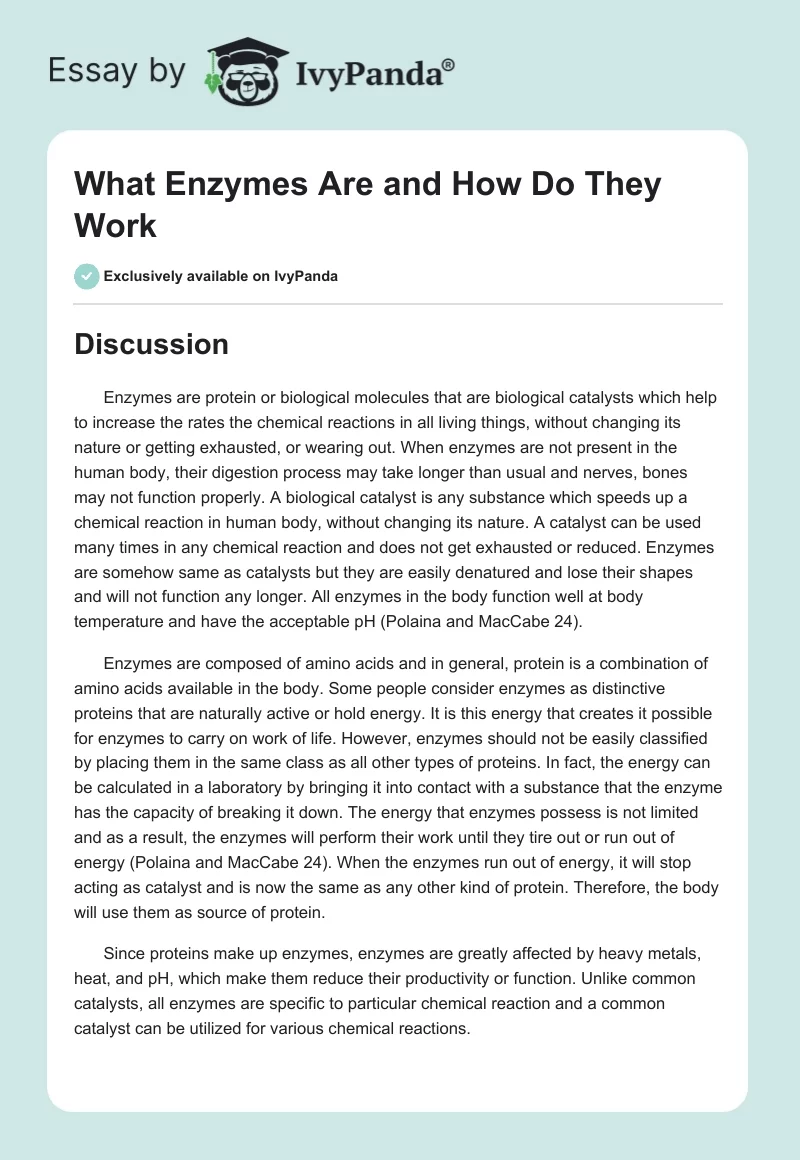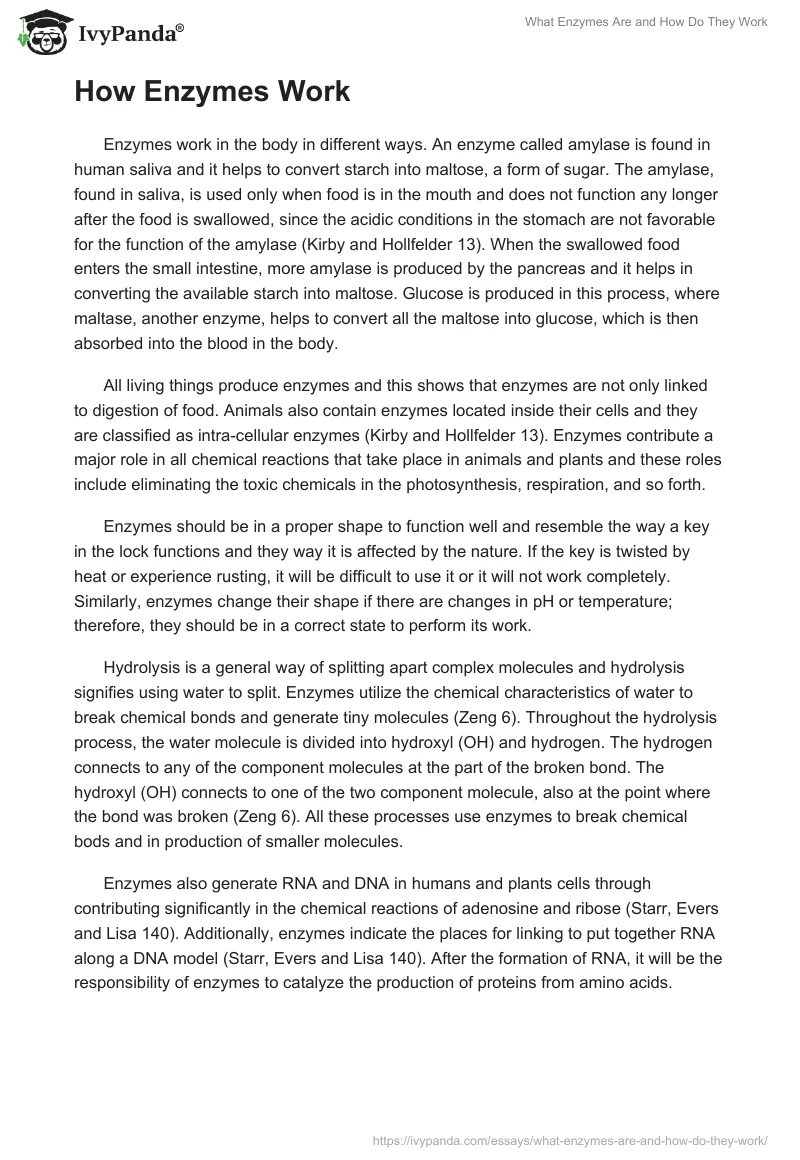Discussion
Enzymes are protein or biological molecules that are biological catalysts which help to increase the rates the chemical reactions in all living things, without changing its nature or getting exhausted, or wearing out. When enzymes are not present in the human body, their digestion process may take longer than usual and nerves, bones may not function properly. A biological catalyst is any substance which speeds up a chemical reaction in human body, without changing its nature. A catalyst can be used many times in any chemical reaction and does not get exhausted or reduced. Enzymes are somehow same as catalysts but they are easily denatured and lose their shapes and will not function any longer. All enzymes in the body function well at body temperature and have the acceptable pH (Polaina and MacCabe 24).
Enzymes are composed of amino acids and in general, protein is a combination of amino acids available in the body. Some people consider enzymes as distinctive proteins that are naturally active or hold energy. It is this energy that creates it possible for enzymes to carry on work of life. However, enzymes should not be easily classified by placing them in the same class as all other types of proteins. In fact, the energy can be calculated in a laboratory by bringing it into contact with a substance that the enzyme has the capacity of breaking it down. The energy that enzymes possess is not limited and as a result, the enzymes will perform their work until they tire out or run out of energy (Polaina and MacCabe 24). When the enzymes run out of energy, it will stop acting as catalyst and is now the same as any other kind of protein. Therefore, the body will use them as source of protein.
Since proteins make up enzymes, enzymes are greatly affected by heavy metals, heat, and pH, which make them reduce their productivity or function. Unlike common catalysts, all enzymes are specific to particular chemical reaction and a common catalyst can be utilized for various chemical reactions.
How Enzymes Work
Enzymes work in the body in different ways. An enzyme called amylase is found in human saliva and it helps to convert starch into maltose, a form of sugar. The amylase, found in saliva, is used only when food is in the mouth and does not function any longer after the food is swallowed, since the acidic conditions in the stomach are not favorable for the function of the amylase (Kirby and Hollfelder 13). When the swallowed food enters the small intestine, more amylase is produced by the pancreas and it helps in converting the available starch into maltose. Glucose is produced in this process, where maltase, another enzyme, helps to convert all the maltose into glucose, which is then absorbed into the blood in the body.
All living things produce enzymes and this shows that enzymes are not only linked to digestion of food. Animals also contain enzymes located inside their cells and they are classified as intra-cellular enzymes (Kirby and Hollfelder 13). Enzymes contribute a major role in all chemical reactions that take place in animals and plants and these roles include eliminating the toxic chemicals in the photosynthesis, respiration, and so forth.
Enzymes should be in a proper shape to function well and resemble the way a key in the lock functions and they way it is affected by the nature. If the key is twisted by heat or experience rusting, it will be difficult to use it or it will not work completely. Similarly, enzymes change their shape if there are changes in pH or temperature; therefore, they should be in a correct state to perform its work.
Hydrolysis is a general way of splitting apart complex molecules and hydrolysis signifies using water to split. Enzymes utilize the chemical characteristics of water to break chemical bonds and generate tiny molecules (Zeng 6). Throughout the hydrolysis process, the water molecule is divided into hydroxyl (OH) and hydrogen. The hydrogen connects to any of the component molecules at the part of the broken bond. The hydroxyl (OH) connects to one of the two component molecule, also at the point where the bond was broken (Zeng 6). All these processes use enzymes to break chemical bods and in production of smaller molecules.
Enzymes also generate RNA and DNA in humans and plants cells through contributing significantly in the chemical reactions of adenosine and ribose (Starr, Evers and Lisa 140). Additionally, enzymes indicate the places for linking to put together RNA along a DNA model (Starr, Evers and Lisa 140). After the formation of RNA, it will be the responsibility of enzymes to catalyze the production of proteins from amino acids.
Conclusion
Enzymes are very important in all living things, since they help in speeding up the chemical reactions. Most living things, such as fungi, bacteria, plants, and animals use enzymes to run all chemical reactions that take place in their body. Synthesis, metabolism, growth, and reproduction, in all animals and plants, are all chemical reactions that are controlled by enzymes (Kirby and Hollfelder 14). Therefore, we can conclude by stating that enzymes are chemicals that contribute significantly in all chemical reactions in the body.
Works Cited
Kirby, Anthony and Florian Hollfelder. From Enzyme Models to Model Enzymes. New York: Royal Society of Chemistry, 2009. Print.
Polaina, Julio and Andrew MacCabe. Industrial Enzymes: Structure, Function And Applications. Dordrecht: Springer, 2007. Print.
Starr, Cecie, Christine Evers and Lisa Starr. Biology: Concepts and Applications. Belmont, CA: Cengage Learning, 2010. Print.
Zeng, Meijuan. Characterization of Cell Wall Deconstruction Induced by Aqueous Pretreatment and Enzyme Hydrolysis. Ann Arbor: ProQuest, 2007. Print.


